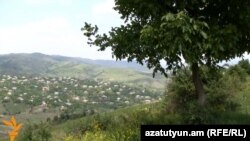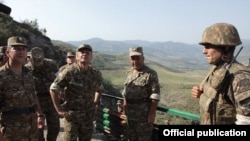One Armenian soldier was wounded in what the Defense Ministry in Yerevan described as intense gunfire opened by the Azerbaijani army on several border villages in northeastern Armenia on Tuesday.
The ministry and local government officials said on Wednesday that Azerbaijani forces shot from sniper rifles and automatic weapons throughout the day. According to them, the gunfire targeted not only Armenian army positions but also Chinari, Aygepar, Movses and Nerkin Karmiraghbyur villages located along the most volatile section of the Armenian-Azerbaijani frontier.
Several village houses as well as a natural gas pipeline in Chinari were reportedly damaged as a result. Gas supplies through the pipeline were restored the following day, officials said.
“There was intense gunfire on Friday but there were many more gunshots yesterday. They rained down on the village like hail,” Andranik Aydinian, the Aygepar mayor, told RFE/RL’s Armenian service (Azatutyun.am) by phone.
Aydinian said village residents had to take cover in their basements and spend the night there. “Children were crying. They were scared,” he said.
The Azerbaijani military also reported fighting in the mountainous area, according to the Trend news agency. It blamed the Armenian side for what was apparently the most serious ceasefire violation in months.
Neither side reported fresh armed incidents on Wednesday. In a short statement, the Armenian Defense Ministry said that “the situation is fully controlled” by its forces. “All necessary steps have been taken to restrain the enemy’s buffoonery,” it said.
Aydinian likewise said that the situation in his village is now peaceful. Parents sent their children to the local school on Wednesday, he said.
Aygepar and the three other villages are located in Armenia’s Tavush province bordering the Gazakh and Tovuz districts in western Azerbaijan. The border section stretching over 240 kilometers saw deadly fighting last year.
Three Armenian soldiers were killed and several others wounded in a single incident near Chinari in June. At least five Azerbaijani soldiers were shot dead at a nearby border position the following morning in what official Baku called an Armenian commando raid.
The upsurge in ceasefire violations coincided with then U.S. Secretary of State Hillary Clinton’s visit to the South Caucasus. Clinton expressed serious concern over those incidents, warning of possible “disastrous consequences” of escalating violence in the Nagorno-Karabakh conflict zone.
The truce at this and other sections of the Armenian-Azerbaijani border largely held in the following months. The Armenian military beefed up its fortifications along the entire frontier, with Defense Minister Seyran Ohanian visiting Tavush in August to inspect what his press office called “large-scale construction work” carried out at Armenian frontline positions there.
Tension in the area rose again when an Armenian soldier serving in Tavush was shot and killed by Azerbaijani forces at the weekend.
Truce violations were also reported last week from the main Armenian-Azerbaijani “line of contact” around Karabakh. Two Azerbaijani soldiers were reportedly killed there on February 5.
The ministry and local government officials said on Wednesday that Azerbaijani forces shot from sniper rifles and automatic weapons throughout the day. According to them, the gunfire targeted not only Armenian army positions but also Chinari, Aygepar, Movses and Nerkin Karmiraghbyur villages located along the most volatile section of the Armenian-Azerbaijani frontier.
Several village houses as well as a natural gas pipeline in Chinari were reportedly damaged as a result. Gas supplies through the pipeline were restored the following day, officials said.
“There was intense gunfire on Friday but there were many more gunshots yesterday. They rained down on the village like hail,” Andranik Aydinian, the Aygepar mayor, told RFE/RL’s Armenian service (Azatutyun.am) by phone.
Aydinian said village residents had to take cover in their basements and spend the night there. “Children were crying. They were scared,” he said.
The Azerbaijani military also reported fighting in the mountainous area, according to the Trend news agency. It blamed the Armenian side for what was apparently the most serious ceasefire violation in months.
Neither side reported fresh armed incidents on Wednesday. In a short statement, the Armenian Defense Ministry said that “the situation is fully controlled” by its forces. “All necessary steps have been taken to restrain the enemy’s buffoonery,” it said.
Aydinian likewise said that the situation in his village is now peaceful. Parents sent their children to the local school on Wednesday, he said.
Aygepar and the three other villages are located in Armenia’s Tavush province bordering the Gazakh and Tovuz districts in western Azerbaijan. The border section stretching over 240 kilometers saw deadly fighting last year.
Three Armenian soldiers were killed and several others wounded in a single incident near Chinari in June. At least five Azerbaijani soldiers were shot dead at a nearby border position the following morning in what official Baku called an Armenian commando raid.
The upsurge in ceasefire violations coincided with then U.S. Secretary of State Hillary Clinton’s visit to the South Caucasus. Clinton expressed serious concern over those incidents, warning of possible “disastrous consequences” of escalating violence in the Nagorno-Karabakh conflict zone.
The truce at this and other sections of the Armenian-Azerbaijani border largely held in the following months. The Armenian military beefed up its fortifications along the entire frontier, with Defense Minister Seyran Ohanian visiting Tavush in August to inspect what his press office called “large-scale construction work” carried out at Armenian frontline positions there.
Tension in the area rose again when an Armenian soldier serving in Tavush was shot and killed by Azerbaijani forces at the weekend.
Truce violations were also reported last week from the main Armenian-Azerbaijani “line of contact” around Karabakh. Two Azerbaijani soldiers were reportedly killed there on February 5.





